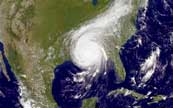 Katrina Update #67
Katrina Update #67 Katrina Update #67
Katrina Update #67This is one of the best times of the year to be in New Orleans. The average temperature is between 65 and 75 degrees, which makes for warmish days and cool nights (nice sleeping weather). It doesn't last long. By April, the average high will be around 80, and as Jazz Fest approaches, humid days in the low to mid 80's will be the norm.
It seems that New Orleans has turned a corner. Perhaps it was Mardi Gras. But talk now seems to be much more of rebuilding and renewal, rather than lack of action and political ineptitude. Maybe it was just timing. Perhaps we have finally reached the "critical mass" of congressmen and senators who have toured the area that enough people finally "get it." New Orleans is different now.
The Rand Corporation was hired by the city to estimate population in New Orleans at designated intervals. They figure there are 155,000 people in the city now, and that it will grow to 272,000 by August 29, 2008. That will be roughly 208,000 shy of its pre-Katrina population. The report notes that 55 percent of the city's 2000 population of 484,000 lived in homes that suffered devastating flooding of at least 4 feet of water. It estimates that less than a third of those properties will be reoccupied by September 2008. For homes with "serious damage," or 2 to 4 feet of water, the RAND report suggests an occupancy rate of 45 percent by late 2008.
By contrast, the report's authors believe population in unflooded areas (the "sliver by the river") will reach 110 percent of pre-Katrina density by 2008, while areas that had minor flooding of less than 2 feet will reach their full pre-Katrina population levels. However, those two categories comprise less than a third of the city.
Travis' mom, Julie Buzzard, arrived in town on Thursday and we picked her up from the airport. On the way back from the airport, we drove through the Lakeview area, and by the now-repaired breach in the 17th St. Canal. The homes, for the most part, have all been gutted. The houses that had been moved from their foundations and deposited in the middle of a street have been removed. The area is pretty much devoid of life. Except for the tour busses. And this is a good thing.
Disaster Tourism isn't new. Thomas Cook started taking British travelers on tours of American Civil War battelfields in 1865. A couple of years later, Mark Twain toured the war-torn city of Sevastopol (Twain chided his traveling companions for picking up shrapnel as souvenirs). People flocked to Mt. St. Helens after she blew in 1980, and the movie "The Killing Field" made Cambodia a tourism destination in the 1980's. Of course, 9/11 presents our most recent incident (until Katrina), with a daily pilgrimage of tourists to the World Trade Center site.
Overall, this is a good thing. 15% of those employeed in New Orleans are either directly or indirectly dependent on tourism, and a full 30% of the city's budget depends on tourism dollars - so we will take it however we can get it. But more importantly, it needs to be seen. Passing by block after block of gutted houses that represent where two-thirds of the city's population once lived cannot be imagined. You have to experience it first hand.
- The state is supposed to have a contractor in place by April 1 to start hauling away the 350,000 abandoned cars that remain in the devastated areas hit by Katrina and Rita. In addition, over 200,000 cars have already been towed away by insurance companies. They figure it will take until July to get all the cars out of the area. The state has already approved one dump site for the cars: a 200 acre site near Garyville, LA in St. John the Baptist Parish. A second site will be needed to hold all of them.
- One of the reasons progress has been so slow in this area is because the state must get permission to enter private property, unless the property has been condemned. In the "Katrina area," as it is called, 28,554 structures have been scheduled for demolition because they are structurally unsound, but only 273 have been demolished so far. In the "Rita area," 2,689 structures have been targeted for demolition, but only 369 have been torn down so far.
- It was reported this week that pre-Katrina there were almost 1,400 businesses operating in St. Bernard Parish. Today there are 113.
- The pre-Katrina population of Pass Christian, MS was about 6,800. Today there are fewer than 1,500.
- In Plaquemines Parish, where almost every structure was destroyed and 40,000 people were left homeless, the levees will be 2-3 feet above pre-Katrina height before June 1, but the Army Corps of Engineers was quick to point out that they were over-topped by 5 feet when Katrina, and then Rita swept through. Because of this, it is estimated that fewer than 25 percent of the pre-Katrina population will return.
HOME | UPDATES | DONATE | GALLERIES | PEOPLE | STORIES | LESSONS | LINKS